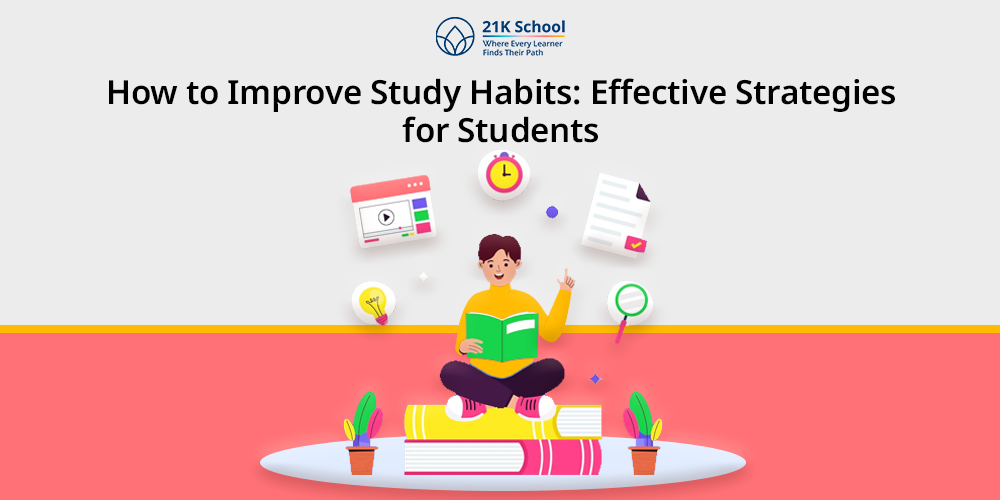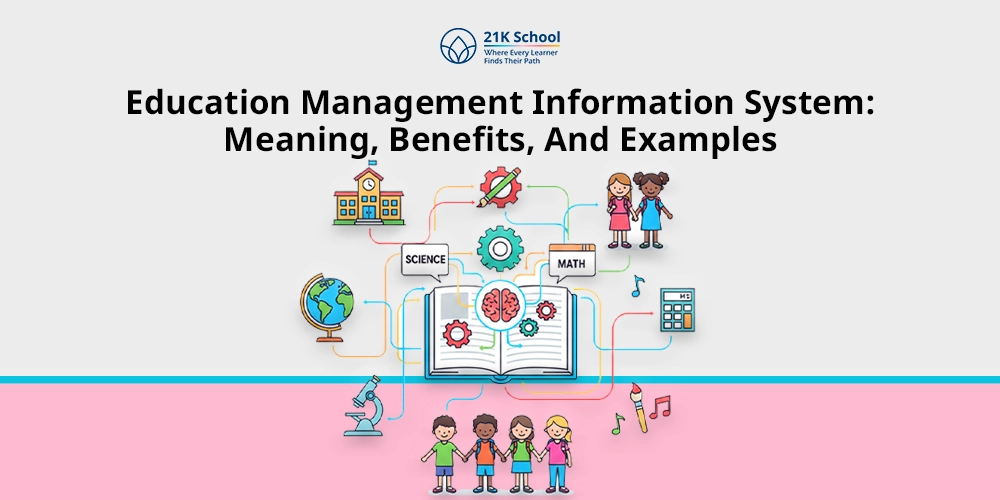
Every parent wants their child to perform well academically. However, success not only depends on intelligence or IQ, it also develops by improving study habits.
A good study habit helps in academic and personal life. From retaining information long run to formation in the real life scenarios.
On the other hand, poor habits decrease the grades and confidence of students. This leads to exam stress and slow career growth.
Here, we will understand what study habits are and how to improve them effectively through different strategies for students’ growth.
Contents
- 1 What Are Study Habits?
- 2 How to Improve Study Habits: Top 10 Proven Ways
- 2.1 1. Create a Consistent Study Routine
- 2.2 2. Set Clear Goals and Priorities
- 2.3 3. Find a Suitable Study Environment
- 2.4 4. Use Active Learning Techniques
- 2.5 5. Take Regular Breaks (Pomodoro Technique)
- 2.6 6. Stay Organised
- 2.7 7. Limit Distractions
- 2.8 8. Develop Effective Note-Taking Skills
- 2.9 9. Stay Healthy and Energised
- 2.10 10. Review and Reflect Regularly
- 3 Bonus Tips- 4 Study Techniques That Actually Work
- 4 Conclusion
What Are Study Habits?
Study habits refers to an individual’s behavior and methods in daily life activities used to learn effectively without any distraction.
Some common examples include learning at a particular time, waking up at 6 every day, writing quick notes for better understanding, completion of homework on time etc.
Developing or improving study habits is not a one day task, it needs a strategy implemented every day to reach the desired goal.
Explore how to make your child study independently .
How to Improve Study Habits: Top 10 Proven Ways
To improve study habits, learners need to work constantly with discipline. Mentioned below are top 10 proven ways beneficial for different age groups:
1. Create a Consistent Study Routine
Consistency is an important part of learning that directly impacts grades. But the question is how to be consistent in learning?
By setting a specific time for everyday studying helps learners to create a habit with time.
Each student is different, that’s why some choose early morning and others like working in evenings. Remember, to stick on schedule.
2. Set Clear Goals and Priorities
Setting a clear goal and prioritising the study routine leads to academic growth. Directionless study doesn’t give miraculous results in the end.
A structured goal with proper alignment and self-confidence improves study habits and ensures good grades in exams .
Start by breaking tasks down into small bite size, use the SMART method (Specific, Measurable, Achievable, Relevant, and Time-bound), align subjects according to difficulty level.
3. Find a Suitable Study Environment
The study environment plays an important role in students’ study, especially in productivity and concentration. One needs to choose a quiet and relaxing place.
Learn how to concentrate on studies .
Remember to avoid setting comfortable so far bed or any other place. Try to reduce the background noise for distraction-free learning.
4. Use Active Learning Techniques
As compared to passive reading, active learning is more beneficial, engaging, and offers good results while studying.
Active learning includes summarising content in its own words, creating mind maps or charts, asking questions and teaching others.
5. Take Regular Breaks (Pomodoro Technique)
Taking a regular break for example 25 minutes learning and 5 minute break is an ideal method also known as “Pomodoro Technique”.
Remember, after four rounds take a long break 15 into 20 minutes for refreshment.
As per facilitators and students the method is effective for high productivity and time management skills .
6. Stay Organised
Stay organised helps in mental clarity, time saving and reduces unnecessary stress in study time. Learn how to cope up with study stress .
Prepare yourself and material before the schedule is planned.
For example, keep notebooks, stationery and other requirements like a water bottom nearby the study table. Ask others to not disturb them while learning.
7. Limit Distractions
Distraction during study time can negatively affect, for example, phones, social media, and multitasking.
Read on to learn more about the screen time for kids .
Keep aside distracting things like turn off device notifications, keep needful material in nearby areas and close doors to avoid outside noise.
8. Develop Effective Note-Taking Skills
By developing effective note taking skills, learners can easily review and revise without wasting extra time.
Some popular ways to help in quick revision are using the “Cornell Method” in which children divide your page to write summary and other important notes.
“Outlining Method” in which structured lists of key points to understand crucial information easily.
9. Stay Healthy and Energised
Continuous learning is not an effective solution. Students need smart work instead of hard work.
Poor health directly impacts individuals brain and body which leads to lower retention and knowledge.
Some personal care such as 7 to 8 hours sleep, take proteins and nutrients and water to improve concentration and memory power for studying .
10. Review and Reflect Regularly
Instead of focusing on exam days, regularly review the key notes to quickly recall and look for improvement.
Keep a journal or weekly review of the content for better understanding and track the progress.
Understand how to study for exams effectively and also explore different study methods .
Bonus Tips- 4 Study Techniques That Actually Work
To improve study habits effectively learners must implement 4 popular study techniques that actually works for long-term retention:
1. Spaced Repetition
Spaced repetition is one of the popular learning methods in which the information is reviewed, increasing order intervals to improve long-run memory and retention in students’ minds.
Instead of reading everyday, students can learn by going on a pattern such as one day, three days, one week, two weeks.
2. Active Recall
As the name suggests, active recall refers to recalling the memory earlier gained to check the retention rate.
By reading the question or topic heading and covering the answer to recall without looking.
3. Practice Testing
Practice testing is one of the best ways to exact results in numbers how learners have performed.
It includes giving a test on a particular chapter or subject learned in previous days or weeks. It is a quick and short practice assignment to help students memorise and specify the area that needs to be revised.
4. Group Study Benefits
Collaborative learning includes group study beneficial for learners which allow them to collaborate, communicate, discuss doubts and share knowledge to gain maximum information.
Remember, to specify a common objective of meeting in group study and add an average number of people three to five people to reduce distraction.
Explore about study time-table for students.
Conclusion
For students, improvement in study habits is a hard but effective learning choice. With unique strategies, a positive learning environment and lifelong learning one achieves academic growth.
By setting objectives, group study, active learning and improving productivity learners can transform their experiences.
Good study habits help in the long run and provide desired results. Start with small steps and improve over time.



